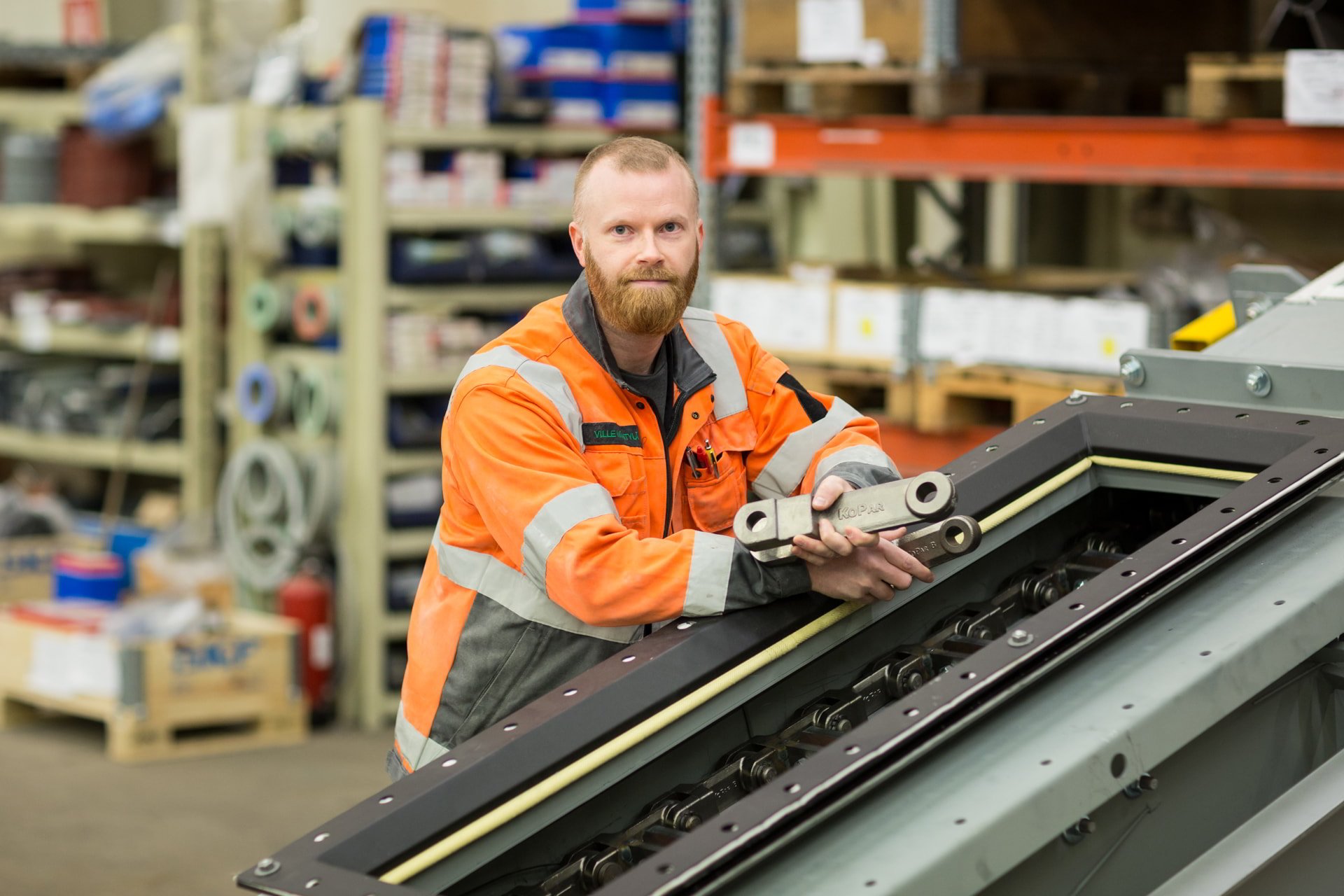Chain conveyors, also known as drag conveyors, are essential industrial solutions in material handling. One of the main features of these devices is their ability to efficiently and safely transport hot ash. The relationship between chain conveyors and drag conveyors is simple: they are synonyms, meaning the same device. This connection provides a clear starting point to delve deeper into the operation, technical features, and significance of chain conveyors in industrial processes.
How do chain conveyors work?
Chain conveyors operate on a simple yet effective principle. They consist of a closed or partially closed channel, inside which paddles move the material. This mechanism is particularly useful in handling hot ash, as chain conveyors are designed to withstand high temperatures. The paddles, or buckets, moving inside the channel transport the material along with a chain driven by a motor.
Chain conveyors can handle different material flows and adapt to various transport directions, such as horizontal, vertical, or inclined movement. This versatility is an integral part of their operation and allows their use in various industrial environments. For example, hot ash can be transported safely and efficiently away from process areas, enhancing safety and efficiency.
High-temperature resistance is one of the most important features of chain conveyors. They can move materials at temperatures up to 700 °C, making them ideal for handling hot ash. This temperature resistance is achieved using special materials, such as boron steel, in the chain manufacturing.
Why are chain conveyors used for transporting hot ash?
The popularity of chain conveyors in hot ash transportation is based on their durability and efficiency features. The design of these devices allows for the continuous and safe transfer of large material quantities, which is an essential requirement in industrial processes. The ability to handle high temperatures without exposing the equipment to damage is a significant advantage.
The use of these conveyors significantly reduces the need for manual labour and increases process safety. Chain conveyors can operate in demanding environments, such as explosive ATEX areas, which enhances their usability in different industrial sectors. Additionally, when equipped with water cooling, a chain conveyor can cool and transport material simultaneously, optimizing process efficiency.
Besides efficiency, chain conveyors offer economic benefits. When material transfer is automated and reliable, both maintenance costs and downtime are reduced. This economic aspect supports the environmental friendliness and sustainability of industrial processes, as energy efficiency and reduced maintenance needs decrease the environmental impact.
What are the key technical features of chain conveyors?
The technical features of chain conveyors make them an excellent choice for handling hot ash. One of the key features is their resistance to high temperatures. This is achieved by using special materials, such as boron steel, which offers significantly better durability than traditional materials.
The capacity of chain conveyors is also a significant advantage. They can transport large amounts of material quickly and efficiently, enhancing the productivity of the entire process. This capacity, combined with their ability to operate continuously, makes them ideal solutions for demanding industrial environments.
Additionally, the customizability of chain conveyors is an important technical feature. They can be designed and manufactured to meet specific process needs, allowing for optimal operation and efficiency. This means that chain conveyors can adapt to different industrial environments and handle various material flows reliably.
How do chain conveyors affect the efficiency of industrial automation?
Integrating chain conveyors into industrial automation processes significantly improves efficiency and safety. They provide an automatic and reliable way to transport materials, reducing the need for manual labour and minimizing the possibility of human error. This leads to smoother and faster processes.
In the context of industrial automation, chain conveyors optimize material flows, enhancing production capacity and reducing downtime. This is particularly important when handling large amounts of hot ash, as efficiency and continuity are crucial for production profitability.
Safety is also a key factor in the impact of chain conveyors on industrial automation. The use of these systems reduces physical strain and improves workplace safety, which is important for both employee well-being and the operation of production facilities. Efficient transportation systems, such as chain conveyors, support the smoothness and safety of the entire process.
Summary
Chain conveyors, or drag conveyors, are an integral part of industrial material handling, especially in the transportation of hot ash. Their technical features, such as high-temperature resistance and large capacity, make them ideal for demanding industrial environments. By integrating chain conveyors into industrial automation processes, efficiency, safety, and environmental impact can be improved.
While there are challenges in using chain conveyors, such as maintenance and safety considerations, the benefits they offer are significant. It is important for industrial operators to consider the use of chain conveyors in their processes and assess their potential to improve production efficiency and sustainability. Proper utilization of these devices can be key in the industry's green transition and the promotion of more environmentally friendly practices.

You have a challenge that needs solving?
Let us help! Contact us for more information about our products and services.
